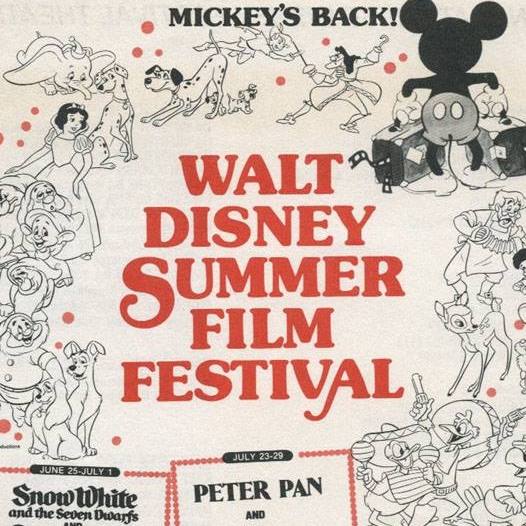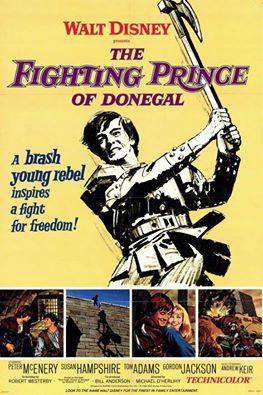“I brought you some bread if you’d like it.”
”Why thank you Brigette.”
“How do you know my name?!”
“A girl as pretty as you would have to be called Bridgette.”
That little exchange between Tom Adams and Marie Ni Ghrainne seems innocuous enough, but is hilarious within the film.
50 years ago today Walt Disney’s classic “The Fighting Prince Of Donegal” was released, the last new film of his to be released while he was still alive.
“The birds will gather in their hundreds, when Hugh succeeds Hugh as Prince of Donegal, and Ireland shall be free.”
Peter McEnery stars as Hugh O’Donnell, who becomes prince in that haunting opening, with birds flying, showing the passing of the prince’s father, at a time of great turmoil between Ireland and England (so what else is new). O’Donnell wants to get all the Irish clans to form an alliance, to go against the Queen and bargain so that they be left alone, and free.
He gets the McSweeney’s and O’Neill’s to join him, but the Queen has the Prince captured, imprisoned, and he must escape, to finally fight with the clans, and hopefully get freedom for Ireland.
“The Fighting Prince Of Donegal” is an extremely exciting swashbuckler, and lavishly mounted, with great location work, shot at Pinewood studios in England (which I guess means that nothing was shot technically in Ireland, though you’d never think it from the amazing looking results). The love story is also nicely handled, strengthening as the story develops.
The cast is excellent, made up of English and Irish actors, most of which made few films in the United States:
Peter McEnery is quite a commanding presence, creating great conflict and tension for the plight of his people, as well as still being human. Outside of his previous Disney film “The Moon Spinners”, I haven’t come across any other films of his, and it is a pity that there aren’t any other major films known of this engaging actor. His action scenes make him quite formidable.
Susan Hampshire plays Kathleen McSweeney, and she was a delightful actress, who could bring great depth, as well as great beauty. Her role in the classic “The Three Lives Of Thomasina” is quite different than in this film, here more of a young, sprightly lass, while in “Thomasina” she was a much more mysterious, mature character. It’s two years later, and she’s seemingly playing a much younger character. Hampshire had some international hits outside of Disney, with “Those Magnificent Men And Their Jaunty Jalopies” and “Living Free”, the sequel to “Born Free”, with Nigel Davenport.
Tom Adams plays Henry O’Neill, a combative friend of Hugh, in a delightful performance. Adams steals the film, with a wonderful sense of humor and fun, not to mention causing a lot more trouble than he should. He is an extreme flirt, and in one very unique scene encounters three different daughters, and their mother. It is the most humorous moment in the film, and after that one can’t help but adore this rascal; beautifully handled.
Gordon Jackson is Captain Leeds, one extremely revolting villain, who’s petty desires for cruelty occasionally backfire on him. Leeds is one dangerous man, evil and cowardly, which Jackson shades beautifully. Jackson is excellent here as a nasty, but he played a wonderful person in “Greyfriars Bobby” 5 years earlier, and he was apparently a very beloved actor in England, a real life prince of a person. He married Rona Anderson, and was married to her for 49 years. Rona played one of the most beautiful human beings ever depicted on the screen: Alice in 1951’s “A Christmas Carol” with Alastair Sim, the girl he leaves behind, to regret it for all eternity; Alice who dedicated her life for the poor. Mr. Jackson married Alice; that’s poetry.
Andrew Keir plays Lord McSweeney, Susan Hampshire’s father, and he is a rambunctious, drinking Irish teddy bear of a man. Keir had an innate humanity that always showed in his work, prominent in “Quatermass And The Pit” (AKA: “Five Million Years To Earth”), playing Professor Bernard Quatermass in the third film of the series (following Brian Donlevy). Here he is a boisterous, emotional man, who’s trusting nature leads the whole story into danger for Hugh, but who will do much to help Hugh and Ireland. You’d always want Keir on your side.
Norman Wooland as the Viceroy is very sympathetic, in the unpleasant position of having to carry out the Queen’s order of holding the prince hostage, though he, and the queen, would rather not.
Donal McCann plays Sean O’Toole, the cripple who tries to help Hugh escape prison, twice. A very likeable character, who does much to help his prince.
Maurice Roeves plays Martin, the water boy who will try to free our heroes, and potentially free his own shackles. He also ends up being very heroic.
Marie Kean is the mother, Fidelma Murphy, Marie O’Neill and Marie Ni Ghrainne are the three daughters who Hugh and Henry encounter while on the lam, and are the source a lot of fun, a scene that humanizes their characters greatly.
The tensions in the story, and the final big attack on the castle are beautifully handled by director Michael O’Herlihy, his first Disney project. The attention to detail, and making the story have constant movement and incident, are quite spectacular. It is a very involving film, with great conflict. O’Herlihy would go on to do for the studio “Willie And The Yank” for TV, “The One And Only Genuine Original Family Band”, “The Young Loner” for TV, and the classic “Smith”. He was mainly a television director, his three Disney theatricals being his only theatrical films, a pity since he handled each with great skill and detail (rather astonishing that these were his only major motion pictures).
The screenplay was by Robert Westerby, who had a long career in England, and who would end his career at Disney. He wrote the scripts for “Greyfriars Bobby”, “Dr. Syn Alias The Scarecrow”, “The Three Lives Of Thomasina”, “The Legend Of Young Dick Turpin” and “Ballerina”. “Donegal” would be his last film, passing away two years later; a man of great talent.
The wonderful score is by the great George Bruns, creating great conflict in the action. There is one moment where he uses a few notes from “The Absent-Minded Professor” late in the film, which was fun to catch.
The film was shown the following year on NBC television, in October of 1967, its one network airing, in 3 parts, and wouldn’t be seen again until 1983 on The Disney Channel. For such a wonderful film to get so little attention is a great pity, and, though it has been released on DVD, it has yet to be letterboxed. It is a lavish, spectacular looking film, with great costumes, and a sense of historical authenticity.
“The Fighting Prince Of Donegal” is a classic swashbuckler, the last the studio would do (outside of a 1984 Disney Channel film, “Black Arrow”), the kind of film that started full live-action films at the Disney studio in 1950 with “Treasure Island”, all made in England, and all at Pinewood studios. They would still do several more films in England, but there were no more swashbucklers. They finished with a bang.

